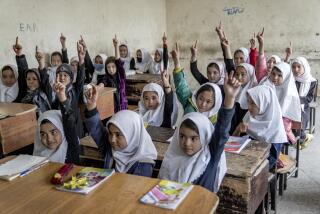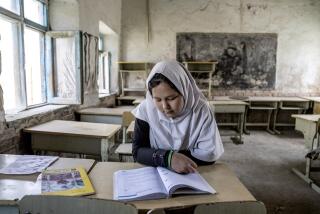Afghan Girls Hunger for Denied Education
DIR, Pakistan â âMy name is Zeba,â the girl in the long white shawl and sky-blue school uniform announced boldly in English, âand my father is Fazel Mohammed.â
Zeba, 12, can rattle off her ABCs, read and write in her native Pushtu language and solve multiplication and division problems. She is ready--bubbling with eagerness--to advance to middle school and beyond.
âIâd like at least to go until the 12th grade,â she said hopefully in the primitive three-room schoolhouse where she has emerged as a top student.
But at the Berari refugee camp where the Afghan girl lives in Pakistan, there is no middle school for girls--or boys, for that matter. No high school. No beyond. This poses a major question, possibly critical for the future of Afghanistan: If Zeba, daughter of Fazel Mohammed, is not educated, who will be?
Zeba and other Afghan girls her age are in a bind because inside Afghanistan, the Muslim fundamentalist Taliban movement has closed all schools for girls and women. Meanwhile, in the Pakistan refugee camps where an estimated 1.2 million to 1.8 million Afghans still live, education beyond the sixth grade has been halted because of severe budget cuts in international aid for the refugees.
The problem here in Pakistan is not fundamentalism but lack of money--what one concerned U.N. official described as âdonor fatigue.â
For Afghan girls, the results are particularly troubling. Oppressed at home and abandoned in exile by the international aid community, a generation of Afghan girls finds itself blocked from higher education.
*
The tragic irony is that education has never been so sorely needed nor so much in demand in a culture--primarily ethnic Pushtun--that traditionally has resisted female schooling. âThe refugee camps may be the last or only remaining organized, encouraged education of women in the Afghan community,â said U.N. refugee official Marta Juarez.
Juarez and other aid officials are hoping that the international aid community will begin to view the education of Afghan children in Pakistan as a priority separate from the question of overall support for the greater refugee population.
Malang Eborhimi, an Afghan refugee who works in the camps as a U.N. social worker, observed: âIn Pakistan, we still have the possibility to educate our girls. No one knows when that opportunity will return in Afghanistan.â
Adina Asfandiar, 25, a primary school teacher in the Berari camp who four years ago fled Kabul, the Afghan capital, sees education of the young refugee girls as a mission to save her country.
âSomeday, when peace returns to Afghanistan,â said the Kabul University graduate, pointing to the clump of 11- and 12-year-old girls sitting attentively on the dirt floor of her crowded classroom, âthese children will be the seeds for the rebuilding of our country. They may be barefoot and unwashed, but they are intelligent and bright. They are like a blank piece of paper. It hurts me deeply that there are no further opportunities for these girls.â
Among those in the class recently were eight girls, including Zeba, who are repeating the sixth grade because they have no school and no books for the next level. The teachers sometimes ask them to help tutor the younger girls.
The older girls--who have dreams of becoming teachers and health workers--are stalled, unable to return to their homeland and abandoned by traditional refugee support systems.
The main cause of the problem is that the rise to power of the Taliban in Afghanistan came as money-strapped U.N. and Pakistani agencies were withdrawing support for Afghan refugees.
âItâs really a case of general donor fatigue,â said Jacques Mouchet, the senior official in the region for the Office of the U.N. High Commissioner for Refugees. âThe world media attention is no longer on Afghanistan. Financing has become more and more difficult. Nongovernmental agencies are closing down right and left.â
Hoping to encourage Afghans to return home, the U.N. refugee agency cut off all direct food aid in 1995 after the number of Afghans in Pakistan began to fall from a high of 4 million in 1988 during the Afghan War. Most are concentrated here in Pakistanâs rugged North-West Frontier Province. Included in the census of refugees are an estimated 400,000 recent arrivals who fled the militant orthodoxy that the Taliban has installed in the territory it controls, roughly two-thirds of Afghanistan.
Even in areas not under direct control of the Taliban--such as Mazar-i-Sharif, a major agricultural area in northern Afghanistan--education of female students has come under attack. Recently, the main university in Mazar-i-Sharif, previously coed, was divided into male and female sections. Most classes for women were reportedly canceled.
*
Under a special âsafety netâ program, the U.N. refugee agency has been able to provide food and health care to needy cases in the Pakistan camps. In most of the camps, the United Nations still supports primary schools for boys and girls. But almost all middle and high schools in the 140 refugee camps have been closed because of funding cutbacks.
Some refugee boys, who are freer to travel in the restrictive Afghan culture, have been able to continue their education in Pakistani or private schools.
In Peshawar, the capital of North-West Frontier Province, private groups have been able to keep alive a handful of secondary schools for girls, including one high school. In Iran, despite the conservative religious regime, Afghan refugee girls are still receiving basic education.
But the problem of education for women and girls is most acute in remote areas of Pakistan, where most of the refugees are housed. According to the latest estimates, only about 4,000 Afghan refugee girls are receiving education, compared with more than 35,000 boys.
âThis is a problem more critical here than in any other place in the world,â said Rupert Colville, a spokesman for the U.N. refugee agency in Islamabad, the Pakistani capital. âIf you are not trying to educate the refugees--especially the girl refugees--you are in danger of losing a whole generation.â
Aid groups are hoping that the crisis will prompt a new kind of donor support, different from that given to Afghan refugees when the countryâs moujahedeen forces were battling Soviet troops during the 1980s.
Ironically, the problem emerges as demand for educational opportunities for girls has never been higher.
âWhen the refugees first came to Pakistan after the 1979-80 Soviet invasion, education was anathema,â said Nancy Dupree, a U.S. expert on Afghanistan who directs a research center in Peshawar. âThe refugees were mainly a rural population. They looked upon education as the road on which communism came to Afghanistan. It was only the educated people in Kabul who supported the Communist regime.â
But the refugee attitude toward the education of women and girls appears to have softened. At the time of the Soviet invasion, only 3% of Afghanistanâs adult women, mostly in cities, had a basic education. The nearly two decades of war have probably lowered that rate, already one of the worldâs lowest. But because it is so low, educating enough refugee girls in Pakistan and Iran could improve the prewar record.
Another factor contributing to the growth of support for schooling in the Afghan refugee communities is an incentive program operated by the U.N. World Food Program that every month distributes a gallon can of cooking oil for each girl in the family who enrolls in school.
*
Beyond the broad need to foster an educated generation prepared to tackle Afghanistanâs challenges, food program sponsors see many practical long-term benefits from such incentives. Studies have consistently shown that educated women marry later, have fewer children, practice better nutrition and encourage their own children to become educated.
Since the incentive program was instituted in the Berari camp, located on a rocky slope only a few miles from the Afghan border, the female population at the school has increased from 76 to 142 students in less than two years.
Finally, that the Taliban, a rural-based all-male militia, has curtailed education for women and girls back home has caused Afghan refugees to reassess traditional attitudes. In the refugee camps, elders talk of the hypocritical Taliban leaders who ban education for girls inside Afghanistan but send their own daughters to Peshawar to school.
âEnthusiasm for girlsâ education has never been higher here,â Dupree said. âThe refugees have been exposed to the benefits. They can see that education is not the road to communism.â
More to Read
Sign up for Essential California
The most important California stories and recommendations in your inbox every morning.
You may occasionally receive promotional content from the Los Angeles Times.










